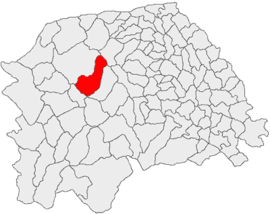Vatra Moldoviței
German: Watra Moldawitza | |
|---|---|
 Moldovița painted monastery, UNESCO monument, part of the Churches of Moldavia | |
 Location in Suceava County | |
| Coordinates: 47°39′N 25°34′E / 47.650°N 25.567°E | |
| Country | Romania |
| County | Suceava |
| Established | 1402 (first attested) |
| Area | 17.02 km2 (6.57 sq mi) |
| Highest elevation | 1,380 m (4,530 ft) |
| Lowest elevation | 588 m (1,929 ft) |
| Population (2021-12-01)[1] | 3,779 |
| • Density | 220/km2 (580/sq mi) |
| Time zone | EET/EEST (UTC+2/+3) |
| Postal code | 727595 |
| Area code | +40 230 |
| Vehicle reg. | SV |
| Website | Vatra Moldoviței Townhall site |
Vatra Moldoviței (German: Watra Moldawitza or Moldowitza-Watra)[2] is a commune located in the western-central part of Suceava County, in the historical region of Bukovina, northeastern Romania.
It is composed of three villages, namely: Ciumârna, Paltinu, and Vatra Moldoviței. The latter village is the site of the UNESCO World Heritage Site Moldovița Monastery. It lies on the banks of Moldovița River and some of its tributaries Ciumârna and Paltinu. It is flanked by two of the Bukovina Ridges (Romanian: Obcinele Bucovinei): the Great Ridge (Romanian: Obcina Mare) and the Feredeu Ridge (Romanian: Obcina Feredeului).
The first official record referring to the Vatra Moldoviței area dates to the time of Alexander the Good, who founded the Moldovița Monastery in 1402. In the past, in its relatively recent history, more specifically in the modern period and up until the mid 20th century, the commune was also home to a sizeable German population, more specifically Bukovina Germans.
Vatra Moldoviței is also part of the Via Transilvanica long-distance trail.[3]
History
[edit]
Moldavia (1388–1775)
Habsburg Monarchy (1775–1804)
Austrian Empire (1804–1867)
Austria-Hungary, Cisleithania (1867–1918)
Kingdom of Romania (1918–1947)
Romanian People's Republic (1947–1965)
Socialist Republic of Romania (1965–1989)
Romania (1989–present)
The commune was first attested during the early 15th century. Subsequently, several centuries later, part of the historical region of Bukovina, Vatra Moldoviței was under Habsburg and Austrian rule (being part of the Duchy of Bukovina, Cisleithania) until 1918 when it became part of the Kingdom of Romania.
Administration and local politics
[edit]Communal council
[edit]The commune's current local council has the following political composition, according to the results of the 2020 Romanian local elections:[4]
| Party | Seats | Current Council | ||||||||
|---|---|---|---|---|---|---|---|---|---|---|
| National Liberal Party (PNL) | 8 | |||||||||
| Social Democratic Party (PSD) | 3 | |||||||||
| Union of the Ukrainians of Romania (UUR) | 2 | |||||||||
Gallery
[edit]-
Panoramic view of Vatra Moldoviței
-
The narrow-gauge steam train Huțulca-Mocănița-Moldovița in Vatra Moldoviței
-
Moldovița forest railway
-
Moldovița forest railway
-
Moldovița forest railway
-
Inside Moldovița Monastery
-
Inside Moldovița Monastery
-
Inside Moldovița Monastery
References
[edit]- ^ "Populaţia rezidentă după grupa de vârstă, pe județe și municipii, orașe, comune, la 1 decembrie 2021" (XLS). National Institute of Statistics.
- ^ "Southern Bukovina German villages – 1940" (PDF). Retrieved 17 September 2022.
- ^ "Bucovina | Via Transilvanica". www.viatransilvanica.com. Retrieved 2023-08-10.
- ^ "Rezultatele finale ale alegerilor locale din 2020" (Json) (in Romanian). Autoritatea Electorală Permanentă. Retrieved 2020-11-02.











Well, that’s interesting to know that Psilotum nudum are known as whisk ferns. Psilotum nudum is the commoner species of the two. While the P. flaccidum is a rare species and is found in the tropical islands. Both the species are usually epiphytic in habit and grow upon tree ferns. These species may also be terrestrial and grow in humus or in the crevices of the rocks.
View the detailed Guide of Psilotum nudum: Detailed Study Of Psilotum Nudum (Whisk Fern), Classification, Anatomy, Reproduction